
















I wanted to take this opportunity to introduce myself and say what a privilege it is to be working with Pulford Publicity. I relocated to Dorset eight years ago, mainly so I could walk my dog along this stunning coastline, on a quest for a good work-life balance. This really is such a beautiful place to live and I am so grateful that I have somehow found myself calling this area home. I have learnt so much already from our fantastic contributors and hope you find their articles interesting too. From the history of the lighthouses in the UK to planning your next holiday abroad - Sri Lanka sounds wonderful in Sally’s article. Will you be taking part in UK Swift Awareness Week in July? Read all about it in CHOG’s article. Finally, don’t forget to find Sammy the Seagull somewhere on these pages and enter The Regent’s competition.
Rebecca Smith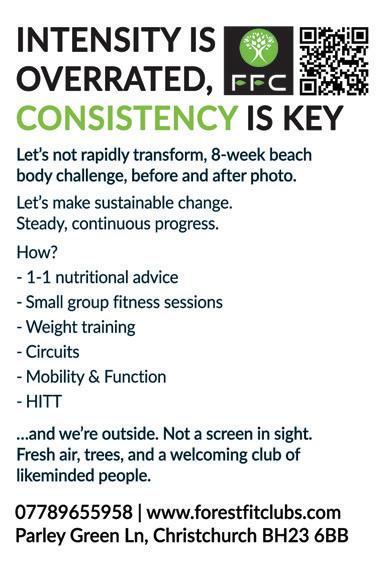






Every letter of the alphabet has been replaced by a number.
All you have to do is decide which letter is represented by which number.
To start you off we reveal the code for 3 letters.
Solutions on page XXII



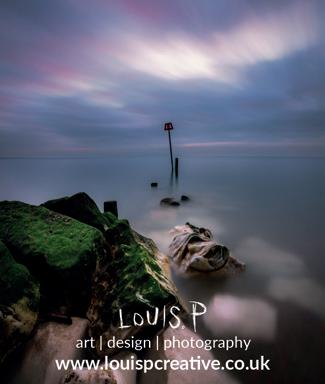 sponsored by Louis P Creative
sponsored by Louis P Creative






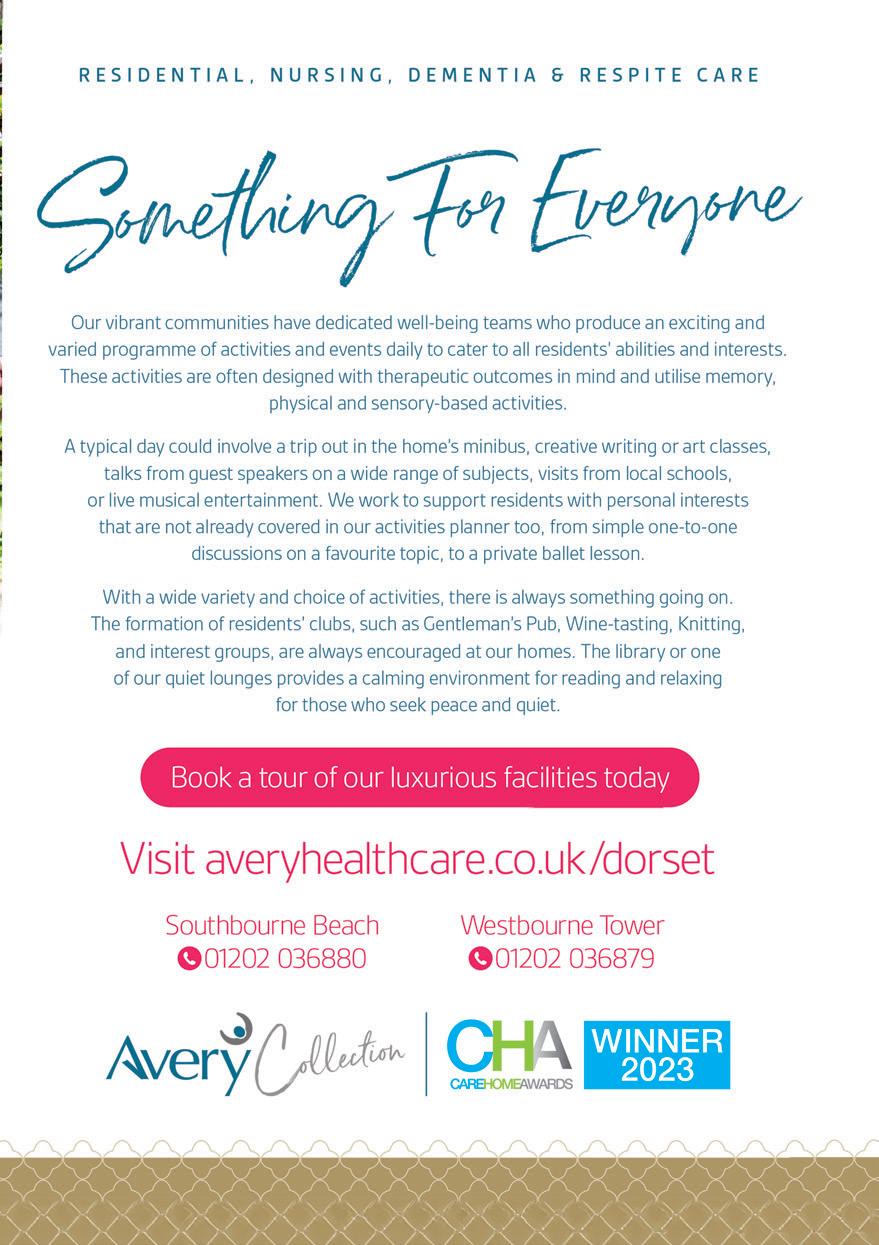
35% of people suffer from OCD.
O=obsessive thought
C=compulsive behaviour that you need to perform to alleviate the unpleasant feelings caused by the thought
D=disorder
For these sufferers, lives can be made miserable by frightening, intrusive and repetitive thoughts or impulses requiring the urgent need to perform specific actions in order to feel ok. The most common activities are repeated hand washing and checking activities (gas turned off, door locked etc). OCD behaviour is usually triggered by a STEEP RISE IN STRESS in our lives. The difference between OCD and going back to check the door is locked once, is the degree of distress that the ritual causes and the degree and quantity of times the act must be carried out. The whole process impacts the sufferer’s ability to function efficiently day to day. Repeated compulsions take

up a lot of time and often cause avoidance tactics to avoid triggers. Obsessive thoughts destroy concentration and lead to exhaustion and may affect our ability to work, impact relationships leaving us ashamed, lonely, and anxious. Your obsessional thought may be fear that others will die or that you may inflict harm on someone if you do not perform the compulsive act. The compulsive behaviour is thus performed in an attempt to block the thought. Sufferers know that their behaviours are irrational and often suffer thoughts of helplessness and guilt and the whole process causes distress. The fear generated if unable to carry out the behaviour can be unbearable. The behaviour eg handwashing may need to be carried out 50+ times a day, following a set pattern and if the ritual is disturbed, may need to be repeated all over again. In order to regain some control, the sufferer needs to treat OCD as a bully. OCD is bullying you to perform the ritual so that the feared event does not occur. It’s blackmailing you, raising the stakes, extending the punishment, and still not letting you go free. So, when you get the OCD thought, recognise that is what it is, don’t engage with it, don’t focus your attention on it and the associated anxiety will be mild and will pass. Immediately focus your mind on something else pleasurable that you have prepared earlier – put on music, run up and down stairs, 7/11 breathing, call a friend. As you stop doing your rituals you will realise that whatever you feared has NOT happened. The more you avoid performing the ritual (not by getting tense and resisting) but by dismissing the thought and concentrating on something else, the more the connection between the thought and ritual will fade.
Dr Armorel Wood mBACP Accred mNCS Private counsellor 07765 915211
Mapletreetherapy.org.uk woodarmorel@gmail.com




by Neon Squid, hardback £19.99
Heard about the lizard that shoots blood from its eyes? Or the ancient Romans who used wee as mouthwash? Did you know that going on a rollercoaster can cure kidney stones?
In this compendium of obscure facts, readers will be treated to baffling knowledge they would never learn at school. Broken into chapters including geography, space and history, a team of experts has scoured the world to find the silliest and most pointless facts that it has to offer. Accompanied by hilarious illustrations, kids will meet the prehistoric camel with no humps, the tortoises that went to the Moon (and came back again), and dancing cave people. They will learn crucial life skills like how to walk on custard and how to unboil an egg by spinning it 5,000 times a minute. And they will read the heart-warming story of a court jester called Roland the Farter – can you guess what his special skill was?

by Robert Galbraith, paperback £10.99
This long-awaited paperback edition of the seventh book in the Cormoran Strike series was published in June. Private Detective Cormoran Strike is contacted by a worried father whose son has gone to join a religious cult in the depths of the Norfolk countryside. The Universal Humanitarian Church is, on the surface, a peaceable organisation that campaigns for a better world. Yet Strike discovers that beneath the surface there are deeply sinister undertones, and unexplained deaths. In order to try to rescue the boy, Strike’s business partner Robin Ellacott decides to infiltrate the cult and she travels to Norfolk to live incognito amongst them. But in doing so, she is unprepared for the dangers that await her there or for the toll it will take on her… If you are new to the series, we always stock the paperback editions of the first six books in the series and thoroughly recommend them.

Caesars by Ferdinand Mount, paperback £12.99
Ferdinand Mount argues that Caesarism is not an absurd throwback to the past, it is an ever-present danger. There are Big Caesars who set out to achieve total social control and Little Caesars who merely want to run an agreeable kleptocracy without opposition: from Julius Caesar and Oliver Cromwell through Napoleon and Bolivar, to Mussolini, Salazar, De Gaulle and Trump. The saga of Boris Johnson and Brexit frequently crops up in this author’s narrative as a vivid, if Lilliputian, instance of the same phenomenon. The final part of the book describes how and why wouldbe Caesars come to grief, from the Gunpowder Plot to Trump’s march on the Capitol and the ejection of Boris Johnson by his own MPs and ends with a defence of the grubby glories of parliamentary politics and a thought-provoking roadmap of the way back to constitutional government.
Why not pop into the shop to have a browse and see lots of lovely new publications for summer? Or you can contact 01202 418403, email sales@bh6booksandhome.co.uk or visit social media @bh6booksandhome to place orders and discover all that is on offer at BH6 Books and Home, 69 Southbourne Grove, BH6 3QU.


Posset ingredients
• 600ml double cream
• 150g caster sugar
• 2 lemons, zest and juice
Method
• Zest the lemons into a saucepan.
• Add the sugar and cream to the same pan and bring it to the boil. (You need to keep an eye on it as it can spill out all over your stove. If this starts to happen, remove from the heat and stir it).
• Once boiled remove from the heat and squeeze in the juice of the zested lemons.
• Whisk together to combine then pass through a sieve into a clean bowl.
• Pour into serving bowls and place in the fridge for minimum of two hours to set.

200ml blueberry juice (available from large supermarkets, or you can juice your own)
Method
• Place the juice in a freezer-proof container.
• Freeze overnight until solid.
• When solid grate using a fork to get the consistency of snow.
• Place back in the freezer until needed.
• Serve on top of the possets. Enjoy straight away.





FRIDAY 16 AUGUST, REGENT CENTRE, CHRISTCHURCH 7.30PM
MasterChef judge Jay Rayner has been the Observer’s award-winning restaurant critic for 25 years, reviewing the very best and the very worst of eating experiences in the UK and beyond. Famed for his good taste, rapier wit and, when it’s called for, his caustic put downs, he has built a massive following. Now, in this intimate evening, Jay shares brilliant stories from his career in journalism, examines what a life in restaurants has taught him, and shares candidly his greatest pet peeves at the table. The night includes an exclusive audience Q&A.
For your chance to win a pair of tickets to the show, simply find Sammy Seagull who is hiding somewhere inside this month’s magazine (excluding this page). Email the page number where he appears and your contact details to competition@themudefordmag.co.uk.
REGENT CENTRE BOX OFFICE
01202 499199
TICKETS £25

Closing date is 31 July 2024


Approaching Christchurch town centre from Purewell, or turning from Stony Lane South, you will cross three bridges over the River Avon, the first of which is Waterloo Bridge. It is followed by Town Bridge and Millhams Bridge (the small bridge over the Mill Stream). Most people easily recognise these latter two bridges, which feature in many photographs of this picturesque part of the town. All three bridges are Grade I listed. However. less notice is taken of Waterloo Bridge, which is rarely photographed, yet it is equally important to access the town centre, and of equally attractive construction.
Given its name it is perhaps easy to work out when it might have been built. On the south side, an inscription reads: ‘This Bridge was built at the expense of the County of Southampton by William Hiscock. Begun June 1816. Finished 1817.’ Of course, it is named after the famous Battle of Waterloo. The official opening was reported in the Salisbury and Winchester Journal on Monday 23 June 1817.
The battle was won on 18 June 1815, and it was also down to William Hiscock’s endeavours that the bridge was ready for the second anniversary of the battle. ‘Mr Hiscock, the builder, used every effort in his power to get the
bridge in that state of forwardness on the day stated, to commemorate the glorious 18th of June…’
The cutting also provides a detailed description of the new bridge. ‘The bridge for strength and neatness, can be excelled by none; It consists of three arches, which are of that beautiful curve called Cycloid; the centre arch is 33 feet span, and each of the others 27 feet. - We cannot omit to notice that much merited encomium is due to Mr Hiscock for the particularly beautiful appearance of the arches; and it is a singular circumstance that there was not the least sinking in either of them on striking the centres, which shews the excellent construction of the masonry.’
The new Waterloo Bridge replaced a previous stone one and it is told that William Hiscock used some of the old stone from the bridge to build a new garden wall at his home in High Street. William’s son, Hiram, was also a stonemason, and they appear together on both the 1841 and 1851 censuses at 19 High Street (now Mathews Shoe Shop). The stone wall is just visible from Druitt Gardens.
www.historychristchurch.org.uk





Recently I have been working on an enquiry for Sri Lanka, putting together a detailed itinerary combining a safari adventure with some relaxation time in a luxury beachfront hotel. Travel Counsellors work with a Destination Management Company in Sri Lanka, they can provide bespoke, unique experiences tailor made to my customers’ requirements. They have first-hand knowledge of Sri Lanka and can offer authentic experiences that are both educational and inspiring. They have local guides who are passionate about the country and will help create lasting memories.
Sri Lanka is a stunning tropical paradise offering unforgettable experiences ranging from pristine beaches, ancient temples and lush tea plantations to National Parks where you’ll be spoilt for choice with animal encounters. Sri Lanka boasts some highly diverse flora and fauna with lakes, wetlands and rivers promoting a flourishing ecosystem.
The itinerary for my customers includes a visit to Yala National Park, where elephants graze peacefully in their natural habitat and there is also the chance to see leopards, playful sloth bears and water buffalo.
Other options for wildlife encounters include Uldawalawe National Park or a river safari along the tranquil waters of the Bentota

 Sally Pullen
Sally Pullen
River where you can see crocodiles, monkeys and graceful birds in their natural habitat.
Whilst in Bentota, you can also visit the Kande Viharaya Temple, it stands as a revered site among Buddhists and is one of Sri Lanka’s most visited temples. The temple houses the tallest sitting Buddha statue in Sri Lanka.
Weligama Bay on the south coast of Sri Lanka is among the country’s best surf spots and is a place to relax after touring or spending time in the National Parks. The central area of Weligama is dotted with upscale boutiques and restaurants. There is also a market which


attracts tourists, residents and weekend travellers from Colombo creating a vibrant, fun-filled atmosphere after a day on the beach.
The picturesque town of Ella is also a popular place to visit. Here you can cross the iconic Nine Arches Bridge aboard the tourist train taking in the breath-taking views, or you can immerse yourself in the local culture at a tea factory witnessing the art of tea making first-hand with some delicious tastings thrown in.
You can also immerse yourself in the colonial charm of Galle, explore the ancient Galle Fortress and the iconic lighthouse. Take a trip to Koggala to witness the traditional stilt fishermen perched skilfully on stilts casting their nets.
From seeing elephants in the wild to mountain climbing and visiting a tea factory or relaxing on the beach, Sri Lanka offers


a perfect combination of adventure and relaxation.
Sri Lanka beckons with a promise of unforgettable experiences and soul-stirring encounters making it a destination like no other.
If you would like to book a holiday to Sri Lanka or need help with any travel plans please get in touch.
 SALLY PULLEN TRAVEL COUNSELLOR
SALLY PULLEN TRAVEL COUNSELLOR
T 01202 375150
M 07929626156
E sally.pullen@travelcounsellors.com
W www.travelcounsellors.com/sally.pullen
Gravel, coastal or Mediterranean gardens as they are often called can be an ideal solution for areas that are exposed to plenty of sun. By planting plants in a thick layer of gravel you are not only creating a beautiful space but helping to suppress weeds and retain moisture in the soil. There are many different types of gravel available.
Here
Summer flowering perennials such as:
• Perovskia Blue Spire – silver green foliage with violet blue flowers
• Lavender – various varieties available
• Agapanthus – stunning blue and white flower heads
• Verbena Bonariensis – ever popular for a long flowering season
• Sedum Autumn Joy – for late summer flowers and winter seed heads
Ornamental grasses:
• Pennisetum ‘Red Buttons’ and many others
Evergreen shrubs:
• Ceanothus and Pittosporum – great looking compact shrubs for all year-round structure
For further advice and detailed planting plans contact Colin Knapman by phone or text: 07925 166767







As we continue southwards down the east coast on our lighthouse tour of England and Wales, we arrive at Southwold Lighthouse. More usually, lighthouses are found on remote headlands but this one is located in the middle of the small seaside town of Southwold amongst rows of houses.
In the 19th Century, the east coast was a dangerous area with around 283 shipwrecks recorded in Southwold Bay’s records. Local fishermen formed beach companies to salvage valuables washed up from sunken ships, but they also helped with the rescue of survivors. Alongside this private enterprise, volunteers formed the Southwold Lifeboat Society in 1840.
The first light at Southwold was a temporary beacon on a wooden structure and was first lit on 19 February 1889. The building of a more permanent lighthouse started in May 1889. The plot was beside the Coastguard Station.
Building the lighthouse would take around 1,500,000 bricks, delivered via Halesworth on the Southwold Railway. It caused an enormous headache for the railway and the local coal merchant, Thomas Moy & Co, whose combined fleet of just 15 goods wagons ran a frenzied shuttle service. However, some 10 months later, the lighthouse lantern arrived from Harwich in two of the Thomas Moy goods wagons. At the time, the low light at Happisburgh was being demolished ahead of the lighthouse actually falling into the sea and so this lantern and optic was reused in the Southwold light.
The present lighthouse came into operation on 3 September 1890. Just six days later, the Argand six wick burner burst into flames and was destroyed. The Argand lamp was replaced and the keepers re-trained. In 1906, the Argand burner was replaced with a Matthews incandescent oil burner. A Hood petroleum vapour burner was installed in 1923 and remained until the station was electrified in 1938.
Over the years, the characteristic of the light changed from occulting twice in every 20 seconds, to six flashes every 20 seconds and finally to four flashes every 20 seconds. Today,
the lighthouse shines over two red sectors; over Sholes to the north and over Sizewell Bank to the south. The range of the sector lights was 15 nautical miles, whilst the white main light had a range of 17 nautical miles.
In 2004, a review of all the lights took place. It was recommended that Southwold be closed the following year as shipping was increasingly using satellite navigation systems. However, Southwold Lighthouse was reprieved in 2009 following a further review by Trinity House, who found that satellite systems had not reached sufficient reliability.
In 2012, Southwold Lighthouse’s light was increased in power to enable its range to reach 24 nautical miles. This was achieved by installing a BVL Topspot 90-volt metal Halide 150-Watt lamp within a small revolving optic. To make space for this within the lantern room, the upper prismatic section of the old optic was removed; one section was put on display at the foot of the tower and the other section was loaned to Happisburgh Lighthouse where it is now displayed. The central and lower sections of the lens are retained as emergency backup.
The light is monitored and controlled by the Trinity House Planning and Control Centre in Harwich.
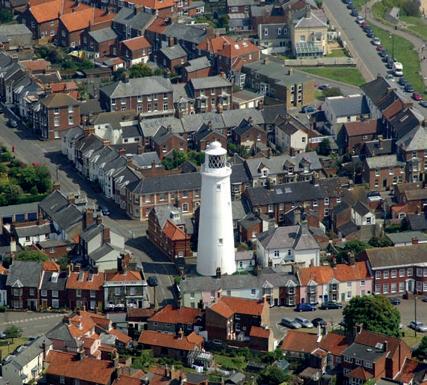

In this month’s issue it is the time of year when the sound of Swifts screaming overhead can be heard and it feels like summer. These trans-Saharan migrants will have flown from as far away as South Africa and are briefly with us before they head back south in August.
Last year we asked for your help in reporting Swift sightings. From the reports we received, locations have been identified for the siting of new single and double Swift nest boxes, which have been made by the Southbourne Men’s Hub. So far, 16 new nest places have been created in the Christchurch area, with 20 in the Southbourne area and two in Somerford. If you are interested in having a Swift nest box fitted at your house, or you would like further information, please contact the Christchurch Harbour Ornithological Group (CHOG) Swift Team at swifts@chog.org.uk
To celebrate their arrival and watch their aerial acrobatics, this summer the Swift Team will be taking part in UK Swift Awareness Week across the Christchurch and Bournemouth area which ends on 7 July 2024. Sharing knowledge about Swifts, raising awareness of the difficulties they face and what we can do to help them will be key topics at these Swift ‘hot spots’. To find out more about the locations and times of the events check the CHOG website or email the Swift team.
In addition to Swifts, many other birds have arrived from their wintering grounds in southern Europe and Africa to breed in the local and wider area. Recent arrivals have included Flycatchers, Ospreys, Redstarts, Swallows, Terns and Warblers. There was even a Nightingale that stopped off for a few days at Stanpit Marsh. During migration time there is always the chance of a surprise rarer visitor, and this spring a Red-rumped Swallow and a Hoopoe added

some continental excitement.
July can be a quieter month around the harbour as birds are busy feeding their young and it is during this time, with the warmer weather, that butterflies, damselflies, dragonflies and reptiles are emerging and being observed. As you can get a bit closer to these sun lovers, it is a good opportunity to enjoy your time outside with them and practise your photography skills.
Christchurch Harbour Ornithological Group, known as CHOG, is an independent organisation and registered charity, which is dedicated to recording, promoting and conserving the wildlife of the Christchurch Harbour area. To find out more about CHOG and how to join, please scan the QR Code or visit www.chog.org.uk for the latest daily sightings and details of meetings, including indoor and online talks as well as outdoor guided walks.

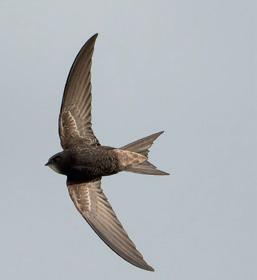











Dental phobia, also known as odontophobia, is a common fear some people experience when visiting a dentist. It can range from mild anxiety to severe panic attacks at the thought of visiting the dentist. This fear can stem from various factors, such as fear of pain, past traumatic experiences, embarrassment about the condition of one’s teeth, fear of needles or drills, or a feeling of loss of control when sitting in the dentist’s chair.
For those who suffer from dental phobia, even routine dental visits can be extremely distressing. However, it’s essential to address this fear because avoiding dental care could lead to significant oral health issues at some point in future.
Statistics show between 5-17% of the world adult population suffer from dental phobia or have some form of dental anxiety. Depending on the severity of the phobia, patients may postpone or totally avoid visiting the dentist unless they are forced, due to severe pain and discomfort. Statistics also show these patients generally suffer from poor oral health, tooth decay and advanced gum disease. The psychological effect of a dental phobia is that a patient goes into a vicious cycle that could lead to further problems in the form of shame and inferiority. This in turn could affect relationships, employment, and lead to social isolation.
Managing dental phobia often involves a combination of psychological strategies and practical approaches. Dentists and dental professionals are increasingly aware of the importance of addressing patients’ fears and creating environments where patients may feel safe. We use techniques such as gentle communication, distraction techniques, relaxation methods like deep breathing or visualisation, and the use of sedation or anaesthesia as necessary.
Several strategies that may help manage dental phobia:
Communication: Speak to your dentist and explain your feelings, then work together to make your visit as relaxed as possible. We are trained to work with anxious patients.
Gradual exposure: Make yourself familiar with the dental environment - starting with simple visits, and gradually progressing to more involved procedures.
Relaxation techniques: Practise relaxation techniques such as deep breathing, mindfulness or meditation to help calm your nerves before and during dental visits.
Sedation options: Dentists can offer sedation options such as nitrous oxide (laughing gas) or oral sedatives to help you relax during procedures.
Behavioural therapy: Therapy techniques such as cognitive-behavioural therapy (CBT) can help address and alleviate dental phobia by changing negative thought patterns and behaviours associated with dental visits.
At Copper Beech Clinic, we have been treating patients with dental anxiety and phobia for over 30 years. We are sensitive to patients’ fear and anxiety – hence, we have created a calm, relaxed and welcoming environment. Our friendly team makes you feel at ease and will to work with you to overcome your fears and become one of the many satisfied patients.
As part of our wellbeing services, we are working with an experienced psychotherapist who is able to support you on site, to help you overcome your dental anxiety /phobia.
Please speak to our team when booking your appointments. We are here to help.
Mrs Ella Aslani DDS Stockholm Principal Dentist – Copper Beech Clinic



The formal opening of Lewis-Manning Hospice Care’s new retail House Clearance Shop in Highcliffe was a celebratory affair attended by locals and members of the Lewis-Manning staff team.
It was formally opened by the newly appointed High Sheriff of Dorset, Anthony Woodhouse.
There was a real buzz as shoppers took the opportunity to look around the shop which was packed with sustainable bargains.
The hospice’s ninth store has opened due to the ever-growing demand for its house clearance services, sustainable goods, as well as the increased need to raise funds for its vital charity services.
Director of Retail, Susan Newcombe, said: “We are really pleased to have secured such a prominent location in this busy part of Highcliffe, with its reputation for being a second-hand searcher’s dream location.
“It’s a great opportunity to let shoppers know about our house clearance and recycling services and how we turn preloved items into extraordinary hospice care for people with lifelimiting illnesses and their loved ones across Poole, Purbeck, East Dorset and West Hampshire.
“We’d like to thank the many businesses who have supported us in preparing for our opening.”
High Sheriff Anthony Woodhouse said he was delighted to open the ninth Lewis-Manning Hospice Care shop: “The shop will be so much more than a place to find a bargain; it will act as a community hub for the people of Highcliffe, a place where people can find out more about the hospice services, volunteering, fundraising and a centre for recycling. The shop will be so important in raising much needed funds for this vital local charity.”
The house clearance service offers flexible, complete or partial house clearances and recycling services. And if you have any preloved items or goods, Lewis Manning can offset the value of them against the clearance costs.
For your free no-obligation quote, call 01202 086051, visit lewis-manning.org.uk/house-clearance or email house.clearance@lewis-manning.org.uk
The House Clearance Shop in Highcliffe is at 288 Lymington Road. Lewis-Manning Hospice Care’s other shops are in Poole, Ashley Cross, Christchurch, Swanage, Westbourne, Winton, Wimborne and Ringwood. Volunteers are always welcome: lewis-manning.org.uk/volunteer-vacancies.



Thanks to everyone who has helped us so far with our 200th anniversary celebrations. You can see some of our smiling faces in the photo taken at the Station on 4 March. We really appreciate that the Mudeford area community are so generous to the RNLI. We hope that you’ll enjoy our emphasis on the FUN in Fundraising with some free to attend events in the next few months.
Join us at the Mudeford Lifeboat Funday on Sunday 11 August. Funfair rides, a variety of stalls, the Mudeford RNLI Crew BBQ, live music, the legendary Duck Race and the inaugural SUP Relay Challenge in the harbour. The event is family-friendly and free to attend, and best of all, the proceeds go directly to supporting Mudeford Lifeboat Station. Follow us on Facebook: RNLI Mudeford Lifeboat Funday
Dates for the diary

For more information on our events or monthly meetings, or to get involved with our Fundraising Crew, please contact Adele at: adele.orr.63@gmail.com We are always pleased to welcome new volunteers for our fundraising team.
Sunday 11 August: Mudeford Lifeboat Fun Day, Mudeford Quay & Green, 11am – 5pm. Free admission.


It’s been years since I had a bath. I know what you’re thinking, but it’s not like that – really it isn’t – I’m not stuck in the Middle Ages. No. Not me. It’s much simpler than that. Life’s always been too hectic to spend half-an-hour wallowing in a bath and I get the impression you know what I mean.
But I was made redundant a few months back and I’m my own boss now. I’ve started a business as an accountant, working from home, and I’ve just secured my first client. So, to celebrate, I’m going to treat myself to a luxurious soak in the bath. All I need is some deep, warm water and bubbles. Yes, you heard right, I might be six foot tall and have a beard but I want bubbles.
First, I have to walk Juno, our Beagle. I can’t upset her routine and to be fair, if I am going to wallow in a hot bath, Juno deserves a longer walk than normal. The idea is to be back by ten. That way I’ll have time for a cuppa while the bath is running.
We’ve got a new coffee machine, you see. We love gadgets. Our house is full of them, but the coffee machine is next level. It makes fabulous lattes and cappuccinos.
While it’s brewing I’ll saunter upstairs, turn the taps on and and slosh bubble bath in the tub.
I expect you’re wondering why I’ve got bubble bath when I don’t have baths. The thing is, Mike gave it to me two Christmases ago. He really has no idea when it comes to buying presents. He gave me fizzy pearl bombs the year before. Hasn’t he noticed that I don’t have baths any more? Maybe he and I have been married too long.
Anyway, Juno can’t wait for her walk. She’s nearly wagged her bottom off at the mention of her favourite word.
We haven’t gone far before bumping into Donald Kanumba, village chatterbox extreme – even in a facemask – which he still wears because Dolores sent it to him. It’s got stars and stripes on it. Donald makes no secret that he’s got a girlfriend stateside. He met her on Facebook and he’s trying to work out how to move to California to join her.
He’ll delay me at least twenty minutes. The thing is, I do like his company and Juno gets on well with his Cockapoo, Buddy.
There’s nothing for it, I’ll re-schedule my bath for eleven. That way, Donald and I can have a good old chinwag and I might find out if Dolores is helping with his airfare.
Oh flip, it’s nearly mid-day, Donald can’t stop talking about Dolores. I’ve told him more than once that I have to get home and he’s still rambling on. At last he remembers he’s got to take Buddy to the vet for his booster and hurries off.
Juno and I are free to go.
I feel ready for that bath as I walk through the front door. I’ll pop upstairs right now. Hang on, there’s a mark on the skirting board. What’s that doing there? I’d better get rid of it or Mike will think I’ve been doing nothing all day. He works as a porter with the NHS. It isn’t the most enviable of jobs I can think of, but he loves it and at least we have a regular income.
Now, where’s the cloth? That’s better. No it isn’t. I’ve made a clean spot and the rest of the skirting looks grubby. I know; I’ll whiz over the whole thing. It won’t take long. There. All done. For heaven’s sake it’s almost one o’clock.
Hmmm, my stomach’s rumbling now. There’s no point trying to relax in a bath when I’m hungry. I’ll knock up a quick cheese salad. I don’t believe it – I’ve dropped it on the
carpet, beetroot and all. I’ll have to do a clean up job. This is so not funny. I’ve had to go over that stain at least six times, but at least it’s vanished. Blimey, it’s twenty to two. I may as well watch the end of Judge Rinder and find out if Mary gets full compensation; she definitely deserves it.
I can’t understand it – I nodded off. That’s not like me. It’s half three. I really must grab that bath.
Oh no. The phone’s ringing. Who can it be?
It’s Mother. I’d better answer it in case she’s in a fix. Fortunately, she isn’t, but I really haven’t got time to talk about the price of bananas. Mothers don’t always take hints do they? It’s gone four and she’s only just hung up.
I’m in a rush now. Mike will be walking through the door in a couple of hours expecting his supper. I sprint into the bathroom, swivel the taps, pour in the bubble

bath and chuck in a pearly thing. It’s not quite the way I thought this would happen.
Then I hurry downstairs to make that frothy coffee. Do people even take coffee into bathrooms? I’ve never done it before, but I need a cuppa and a bath, so why not combine them? It will allow me some extra time for relaxation. As I wait for the coffee machine to work its magic, I listen to the comforting sound of the bath water running. It’s going to be heaven.
With a cup of coffee in hand, I collect a warm fluffy towel out of the airing cupboard and return to the bathroom full of anticipation. Oh bliss. It’s not even five o’clock and...
I look with disbelief. The bath is empty. It’s so long since I’ve had one that I’ve forgotten to put the plug in.
I break out in a cold sweat and hope there’s enough hot water for a quick shower.
So much for bath time.


Thu 4 July: 19:30
Get your dancing shoes at the ready, grab yourself a milkshake and relax - you are in for an evening of back-to-back hits from the 1950s and 60s!
Sat 6 July: 19:30
With acclaimed vocal performances, stunning replica costumes and iconic dance routines, The Take That Experience recreate the magic of Take That live on stage.
Fri 12 July: 19:30
With dazzling costumes, stunning vocals and sensational piano solos, we take you on a journey through Elton John’s life and career, the highs and the lows with many a laugh brought to life, live on stage.
Wed 17 July: 19:30
This five-star hit show from the Edinburgh Fringe Festival is a powerhouse, glittery cabaret with a fierce blend of outrageous vocals, rip-roaring humour and unapologetic horniness!
Fri 19 July: 19:30
Money For Nothing is a tribute to the Dire Straits like no other before, recreating the band’s hits with meticulous attention to detail.
Thu 25 – Sat 27 July
Based on the Hollywood box office smash hit, The Wedding Singer is set to bring you a blast from the past, with all the neon, and fabulous 80s costumes you could imagine!
To see our upcoming film titles, please visit our website www.theregent. co.uk or pick up a film list in-person on your next visit.
All information is correct at the time of publication. Please see our website for the latest information www.theregent.co.uk

Children across Bournemouth, Christchurch and Poole (BCP Council area) will be having splashing fun in the sun this summer.
Redhill paddling pool, Littledown Park paddling pool, The Quomps Splashpark in Christchurch and Hamworthy Park paddling pool should all be open by now following maintenance and safety checks carried out towards the end of May.
The Quomps Splashpark at Christchurch Quay has permanently transferred to Christchurch Town Council, who now manage and operate the site.
James Atkinson, acting town clerk at Christchurch Town Council, said: “The Quomps Splashpark holds a special place in the heart of local people who have enjoyed the facility over the years. Christchurch Town Council is so pleased to be able to secure it for future generations.”
BCP Council is funding the reopening of Redhill paddling pool for this year.
Littledown Park paddling pool (pictured) is managed and operated by registered charity BH Live in partnership with BCP Council.
BCP Council, with a subsidy from The Friends of Hamworthy Park, is funding the reopening of Hamworthy Park Padding Pool this year.
BCP Council also remains keen to speak with businesses and organisations who are interested in sponsoring Redhill paddling pool in 2025 and beyond, following this years’ summer season.


As we head towards summer and the weather gets warmer, we expect to see more people getting back to riding their horses more regularly in Hampshire and the Isle of Wight.
Hampshire and Isle of Wight Constabularly are urging motorists to remember to PASS WIDE AND SLOW when you encounter a horse on the road.
The British Horse Society (BHS) have a web page with dedicated advice to drivers around this topic. Some of the key points to remember when you come across a horse in the road are:
• Slow down to a maximum of 10mph
• Be patient – don’t sound your horn or rev your engine
• Pass the horse wide and slow – at least two metres
• Drive slowly away
You can read the full guidance from the BHS here: https://www.bhs.org.uk/ go-riding/riding-out-hacking/ riding-on-roads/advice-formotorists/
If horse riders need to report an incident to police and have Go-Pro footage, you can report this within 7 days of the incident occurring via ‘Hants Snap’: https:// www.hampshire.police.uk/ police-forces/hampshireconstabulary/areas/hantssnap/hantsnap/hants-snap--report-an-incident/
Feral or semi-feral ponies found in areas such as the New Forest require the same consideration as ridden
horses when approaching or passing.
In the event of a collision with a free-roaming animal in the road, it’s important to stop your vehicle, check on the animal if safe to do so, identify your location and call the police. It is worth downloading the What3Words app on your phone to help you identify exactly where you are – this information can then be passed to a police call handler to help track you down.
Failing to report a collision with an animal is an offence under Section 170(8) of the Road Traffic Act 1988. The animals captured within this piece of legislation are horse, cattle, ass, mule, sheep, pig, goat and dog.


Her Royal Highness The Princess Royal visited the Historic Ships workshop and HMS Victory at Portsmouth Historic Dockyard on 9 May. HRH was joined by Vice Admiral Sir Tim Laurence, Trustee of the HMS Victory Preservation Company, to see HMS Victory’s team of shipwrights and conservationists at work on the 258-year-old ship.
The National Museum of the Royal Navy is fighting to protect HMS Victory for future generations in a 10-year, £42m conservation project.
For an in-depth look at the restoration work happening live visit www.nmrn.org.uk.




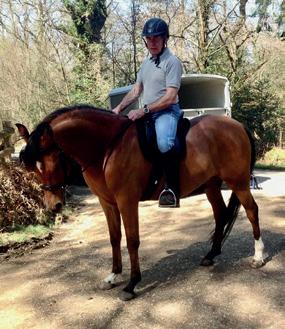





Priory vets is very sorry to report that Philip Hughes passed away on 30th April 2024. Philip worked at Priory for over 40 years, and was very much part of the fabric of the practice. He has had a huge influence on many pets, clients and staff over the years and has enriched all our lives. Without Philip, Priory would not be the thriving independent veterinary practice we are today. Philip was an incredibly well respected member of the entire local community, having spent years visiting farms and homes all over the area, working at the New Forest Show and meeting people while out with his beloved horses and dogs. He will be fondly remembered by so many people. We are very grateful for everything that Philip did and all of us at Priory will miss him very much. We have been very touched by the lovely messages we have received from clients sharing memories of Philip and are grateful for them all. Our thoughts are with his family at this sad time.



Just recently I have changed the way I ‘do’ things at the end of the day, preferring, instead, to take a more mindful approach to the word ‘rest.’ I do things that nurture my mind, my body and my soul. It is all about self-care and it is something I felt the need to share with those who read my articles, in the hope you may relate.
In my younger days, I would feel the need to get things done and sitting down, in a quiet space, felt ‘wrong.’ In fact, I would often come home and then march along the seafront, feeling the need to exercise to an inch of my life, despite my feeling tired. But no more. Of course, an evening stroll, with the sun setting, is always a good choice but I am talking about some even gentler pursuits.
The first thing I do is have a cup of tea. That comes before anything else and is my way of mentally saying to myself, my work is done. There is something about tea don’t you think? Way more nurturing than coffee. I always make sure that I drink from a pretty cup too; mine has my initial on it and is covered in flowers. It really does make a difference.
The TV does not go on, in fact, I sit in silence, enjoying my tea.
I then prep dinner, mindfully. I concentrate on the chopping and prepping of the vegetables and enjoy creating colourful dishes with foods that depict the colours of the rainbow. I am a fan of salads and with the change of the weather, salads are a great staple that can be eaten every day with different ingredients and with a change of meat or fish, according to tastes. Food doesn’t need to be complex, it just needs to be fresh and visually exciting for the eyes, so that our tastebuds fire up and we want to eat the food we have prepared.
Next is shower time, changing into something comfortable before dinner just feels ‘right’.
Once dinner is over, and I’ve cleaned up it’s over to the jigsaw. I have just re-introduced myself
to them, having enjoyed them as a child. There is something rewarding in a jigsaw, not only can the landscape or vision you are creating be inspiring (I often think about framing some of the more inspirational ones), but the creation of your masterpiece can be a challenge. In the words of Poirot, it keeps “those little grey cells ticking.” I don’t know about you, but I always start with the outline first.
Okay, my end of day is not that exciting, but do we really need to be stimulated all the time? There is enough bad news on the TV to overstimulate the quietest of brains and given our busy lives, it’s perfectly okay to practise self-care and that means creating a sense of calm not only in your brain but in your home.
With Love Beth www.thelifestyleconcept.co.uk





In preparation for D-day in June 1944, there was a need for additional airfield capacity in the south of England, so a large number of Advanced Landing Grounds (ALGs) were built, with many in the New Forest. ALGs were designed as purely temporary airfields with landing strips made of steel mesh pinned to the ground with large stakes. The ALGs subsequently moved to France in support of the land operation.
One of these ALGs was at Needs Oar Point near Beaulieu. Needs Oar Point was constructed in the summer of 1943 and four blister hangars were subsequently added. The accommodation was often in tents within the surrounding woodland and aircraft maintenance was conducted from mobile workshops.
From April 1944, it was occupied by RAF British and Commonwealth squadrons flying Hawker Typhoons. Four squadrons with a total of around 150 aircraft flew from here in the buildup to D-Day, supported by more than 900 ground crew. These aircraft carried out attacks on road and rail targets and on radar sites. On D-Day and
the following weeks they flew missions in support of the troops in Normandy.
During the D-day period, Needs Oar Point became the busiest airfield in the country with aircraft taking off or landing every 45 seconds! As with many of the ALGs though, it had been vacated by July and would not be used as an airfield again, subsequently being returned to the Beaulieu Estate.
More information on Needs Oar Point and the other New Forest Airfields can be found at fonfa.co.uk or by visiting the Heritage Centre in Bransgore on open days. There was a D-day 80 memorial service at the Airfields Memorial in Bransgore on 8 June this year.




www.europeanrice.eu
This easy to make recipe by chef Homam Ayaso (aka @Homamino) looks impressive enough to serve on a special occasion.
Prep Time: 10 Min
Cook Time: 20 Min
Serves 4
Ingredients:
2 cups of shrimp
1 fresh lemon
1 large brown onion (or 2 shallots)
6 cloves garlic
2 tbsp butter
1.5 cups European Rice
2.5 cups vegetable broth
Salt and pepper to taste
2 tbsp chopped fresh parsley


• If using frozen or unpeeled shrimp, thaw and peel before starting.
• Juice half the lemon (about 2 tbsp of juice). Slice the remaining lemon for garnish.
• Sauté shrimp both sides for few minutes and set aside.
• Chop onion and garlic. Add to a deep skillet with the butter and sauté over a medium heat for 2-3 minutes.
• Add the European Rice and continue to sauté for 1-2 minutes. You should hear the rice begin to snap and crackle in the hot butter.
• Carefully add the broth, and 2 tbsp of lemon juice.
• Place a lid on the skillet and turn heat to medium-high. Allow broth to reach a full boil then turn heat down to low and simmer for 10 minutes.
• After simmering, most of the broth should be absorbed by the rice. Lift the lid briefly to scatter the shrimp over the surface of the rice.
• Replace lid and allow the skillet to continue to cook over a low heat for five minutes.
• Remove the skillet from the heat and allow to rest, lid in place, for five minutes.
• After resting, lift the lid, and using a fork, carefully fluff the rice and partially stir the cooked shrimp into the rice. Add the leftover lemon slices and sprinkle with extra chopped parsley, if desired.
 Homam Avaso
Homam Avaso


Did you know the world’s most deadly fungus is common in England?
Death cap is responsible for most fatal mushroom poisonings worldwide. These toxic mushrooms have tinted green caps, white stems and white gills and resemble several edible species. They grow on the ground in broadleaved woods and cause kidney and liver failure. Just six to 24 hours after ingestion, symptoms include vomiting, diarrhoea and severe abdominal pain followed by jaundice, seizures, coma and death.
The team at TwentyTwo aims to shed light on the potential dangers of mushroom foraging in the UK’s forests and fields. Foraging has gained popularity as a way to connect with nature and source free, organic food. However, the activity comes with significant risks that cannot be overlooked.
Toxicity: The primary risk of foraging wild mushrooms is the potential for poisoning. Many mushrooms that are highly toxic closely resemble edible ones, making it extremely easy to make a dangerous mistake. Mushroom poisoning can range from mild gastrointestinal discomfort to severe organ damage or death.
Misidentification: Even experienced foragers can make errors in identifying mushrooms. The stakes are high, as a single mistake can lead to serious health consequences. Without comprehensive knowledge and expertise, distinguishing between safe and harmful mushrooms can be challenging, if not impossible, for the average person.
Environmental contaminants: Mushrooms are bio accumulators, meaning they can absorb and concentrate toxins from their environment. Even if a mushroom is edible, it can still pose a risk if it has absorbed pesticides, heavy metals, or other pollutants from its surroundings.
Allergic reactions: Even edible mushrooms can cause adverse reactions in some individuals. Allergic responses can vary from mild to severe and may not be immediately apparent, especially if someone is trying a new type of mushroom for the first time.
Legal risks: Foraging on private property without permission or in protected areas can lead to legal consequences. It’s essential to be aware of the laws and regulations regarding foraging in your area.
Considerations before foraging
Education is key: If you’re determined to forage, invest in comprehensive education. Attend workshops, learn from experts, and use reputable guides to understand the risks and identification techniques.
Health first: Consider the potential health impacts. If you or anyone who will consume the mushrooms has health issues or dietary restrictions, the risks are even higher.
Sustainability: Overforaging can damage ecosystems. Be mindful of the quantity you collect and the manner in which you do it to minimise environmental impact.
Seek expert advice: Before consuming any wild mushrooms, have them checked by a mycologist or a knowledgeable forager. Never rely solely on book guides or internet resources for identification.
TwentyTwo says: “While the allure of foraging can be strong, especially with the promise of connecting with nature and finding natural delicacies, the risks involved are considerable. For many, the dangers may outweigh the benefits. If you choose to forage, do so with caution, respect for nature, and a deep understanding of the risks involved.”
Information supplied by mytwentytwo.co.uk


